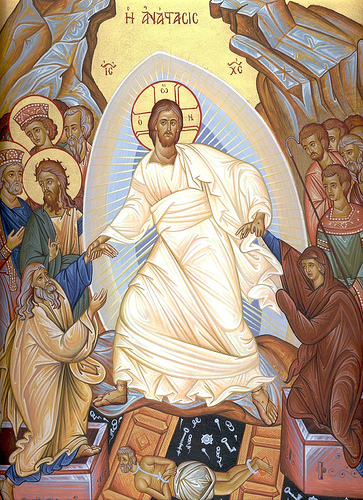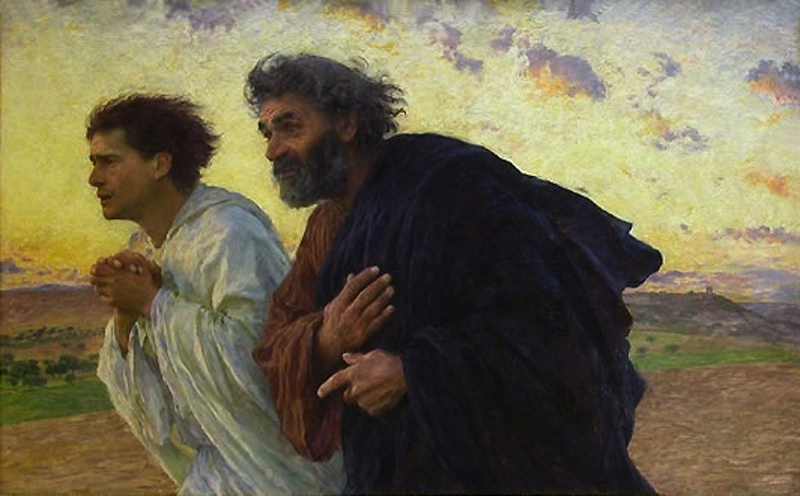Barekmor
Glory be to the Father, to the Son, and to the Holy Spirit
He is Risen!
If we think back a few months ago to Christmas or just a week and a half ago to the Feast of the Annunciation, we remember that Jesus was born from the unviolated virginal womb of the Theotokos. So, also today we see that Christ was raised from the sealed tomb. Christ rose and left the tomb with the seal still intact, just as the Theotokos remains a virgin. The stone and seals were removed after the resurrection so that the disciples could see that He truly was not there.
He was made the firstborn of His mother and today we celebrate that He was the firstborn from the dead. If you take a look at the icon below, you will see Christ taking the hand of an older man and woman. This couple is Adam and Eve.

In His resurrection, He is not only the firstborn of the dead. He has also raised up the race of Adam i.e., us. Hesychius of Jerusalem puts it this way,
Born for the sake of human beings, He rose from the dead with them. On this day paradise is opened by the risen One, Adam is restored to life and Eve is consoled. On this day the Divine call is heard, the kingdom is prepared, we are saved and Christ is adored. On this day, when He had trampled death underfoot, made the tyrant a prisoner and despoiled the underworld, Christ ascended into heaven as a king in victory, as a ruler in glory, as an invincible charioteer.1
Through the resurrection of Christ, we are raised as well. We remember that it is in baptism that we are raised from death to life. We experience the resurrection that we celebrate in our baptism.
We see Mary Magdalene come to the garden and tell St. Peter and St. John that the body of Christ is not there. If we look closely at the words there, we can see how great her faith is. She calls Jesus Lord even though He had died the shameful death of the cross. His manner of death had not shaken her faith in who He truly is.
The resurrection is proclaimed to Jerusalem and the world through the timing of Peter and John coming to the sepulchre. They did not come in the middle of the night but after the sun had risen. Since they did not come in the darkness, no one can suspect them of stealing the body away as the chief priests would later make accusation.

In addition, there is another problem with the priests’ accusation that the Fathers point out. The linen combined with myrrh that the body was wrapped in glues to the body. They say more firmly than lead. I am not real familiar with the properties of lead but suffice to say it wouldn’t be removed from the skin without a lot of effort.
They point out that no thief would take the time to unwrap the body and roll up the napkin and place it apart. A thief, I believe would be trying to get in and get out in the shortest time possible especially with the soldiers “sleeping” just outside the tomb.
Christ putting aside the graveclothes tells us something about his transformed body and our own resurrection bodies. Eusebius of Caesarea explains,
For God, who transforms the bodies of our humiliation so as to be conformed to the body of Christ’s glory, changed the body as an organ of the power that dwelt in it, changing it into something more divine. But he left the linen cloths as superfluous and foreign to the nature of the body.2
Jesus’ body was transformed, just as we will be transformed in the resurrection. In the resurrection we not only see Christ raised, but we see what we will be like. As St. John later writes,
Beloved, we are God’s children now; what we shall be has not yet been revealed. We do know that when it is revealed we shall be like him, for we shall see him as he is.
St. Mary Magdalene came to St. John and St. Peter alone which is put so beautifully in Don Francisco’s song He’s Alive. However, when they go to the tomb to check out the story, we now have two witnesses as required by Old Testament law to verify a fact. Albeit they don’t yet meet Jesus, but they are able to believe the resurrection by virtue of the grave clothes that were left behind.
From that time on, they began to believe that He had burst the bonds of death even though that they didn’t understand the Scripture yet. When their understanding was eventually opened, they had the firm foundation of having seen the empty grave. Their faith would be built on the rock of what they had seen and heard. They would go on to proclaim this eyewitness message to the ends of the earth.
We now see that St. Mary Magdalene returns to the garden to look for her Lord as the disciples return home. She was not satisfied to look once for she loved Him. The Fathers compare her devotion to that of the woman of Song of Solomon who continued seeking until she found her love. Both of them were rewarded because they wouldn’t give up until they found.
The Fathers also encourage us to seek holy things in the same way. If we are seeking to be humble, or to manage our tongue better, or to care more for others etc. and we fail. It doesn’t mean to stop looking for these virtues. It means to return and look again for the Lord so that we can have victory in these areas and eventually see them as a part of our lives.
We see in her a mixture of doubt and love, which kept her from recognising Christ. Through her love, He was revealed to her, but her doubt kept her from knowing Him. If we have doubt this morning in our faith, don’t be discouraged. Hang onto the love we have for our Saviour and He will reveal Himself to you. Doubts will come and go but we must remain faithful in loving Him.
Our Lord asks for the reason of her sorrow so that she would long for Him even more. He desired that she would have an even more fervent love for Him, when asked who she was looking for.
She thinks Him to be a gardener. The Fathers point out that she is not wrong in this thought. While He is not a gardener of plants and flowers, He is a gardener of hearts and His Paradise. He plants virtues and godliness in the hearts of those who love. Him. A picture of this is portrayed in Hannah Hurnard’s book Hinds Feet on High Places. A thread that runs through the book is that the Shepherd plants love in the heart of the main character and removes bad plants out of it through her journey to the high places. This is the idea of Christ being a gardener. He looks after us and gives us the tending that we need.
Jesus says to St. Mary Magdalene do not hold on to me or do not touch me. He says this for several reasons. We will touch on two this morning. First, it was to show that His body was already glorified. During His earthly ministry, He was a servant to everyone, and everyone had power over Him. Tax collectors and sinners used to come and touch Him. But when He was made Lord, when He was glorified, fear of Him was over everyone.
We can see this in a lesser degree to the way the Queen and other government officials are respected. We don’t just go up and touch them. In the revelation that was given to St. John, we can see this difference. In the Gospels He leaned on Jesus’ breast. In the Revelation, He fell at Christ’s feet.
Second, St. Mary represents the Church. St Leo the Great explains this. “You” is speaking of the Church.
I would not have you come to Me as to a human body or recognise Me by fleshly perceptions. I want you to wait for higher things. I prepare greater things for you. When I have ascended to My Father then you shall handle Me more perfectly and truly, for you shall grasp what you cannot touch and believe what you cannot see.3
It is now in the Church that we can see and understand who Christ is. The garden was not the place to experience this seeming new reality. He was now glorified and had overcome sin death and hell. We now worship Him with new understanding.
When we hear that God has become the Father of the Firstfruit of resurrection, we no longer doubt that He has become our Father as well. He took on our flesh and raised it again out of the grave that His God might be our God. We shall enter into heaven after Him where He has gone as the forerunner.
Finally, in the account of the resurrection, we see the sin of the human race returned to where it began.
In Paradise the woman gave the man the deadly fruit, a woman from the sepulchre announced life to men; a woman delivers the message of Him who raises us from the dead, as a woman had delivered the words of the serpent who slew us.4
The fall that occurred at the beginning of the world has been set right.
Let us to have a strong faith so that we will see Christ as Lord no matter our circumstances.
Let us look forward to that day when we will be united with Christ and our bodies will be transformed like His.
We must take the time to cultivate the virtues and must not stop if we fail once but try again and seek the Lord through the virtues. Working with Christ, we must keep seeking until , His nature is perfected in us. We can take it in small chunks. If we have a problem saying wrong things, purpose to say a small number of praises or blessings each day and gradually increase it as God gives you grace. The same way with pride, seek small ways to be humble and so on and so forth with whichever virtue that you are seeking to add to your life.
Let us build our faith today on that of St. John and St. Peter. They saw the empty tomb and proclaimed the message to the world. We must also share this with the world.
Let us rejoice today that the destruction of the fall has been undone. Christ has won the victory. In a few moments we will be partaking of the Eucharist and receiving of that resurrection life.
In the name of the Father, of the Son, and of the Holy Spirit
He is Risen!
Surgun100, Public domain, via Wikimedia Commons
Burnand, Eugène, 1850-1921. Disciples John and Peter on their way to the tomb on Easter morning, from Art in the Christian Tradition, a project of the Vanderbilt Divinity Library, Nashville, TN. https://diglib.library.vanderbilt.edu/act-imagelink.pl?RC=55038 [retrieved May 14, 2021]. Original source: http://commons.wikimedia.org/wiki/File:BurnandJeanPierre.jpg.
1 Joel C. Elowsky and Thomas C. Oden Editors, Ancient Christian Commentary on Scripture New Testament IVb (Downers Grove, IL: InterVarsity Press, 2007), ?
2 ibid, ?
3 ibid, ?
4 ibid, ?